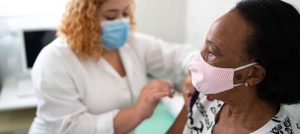Percent of patients with 'extreme' illness on the rise in New Jersey
The highest levels of severe illness were reported by patients with a non-COVID-19-related diagnosis, with 41.7% presenting with a major illness.

Photo: Xavierarnau/Getty Images
Data culled from New Jersey hospitals has found a steep rise in the percentage of patients presenting with "major" or "extreme" illnesses, which has put further pressure on already strained workforces in the state's healthcare institutions. And for once it's not due to COVID-19.
In fact, the highest levels of severe illness were reported by patients with a non-coronavirus-related diagnosis. Some 41.7% presented with a major illness, according to the New Jersey Hospital Association report.
A couple of things are happening. For one, COVID-19 vaccinations and boosters, along with improvements in treatment, have helped to improve outcomes among coronavirus patients. The severity of their illnesses began to revert to pre-pandemic levels.
The other underlying trend is that stay-at-home orders during the pandemic, along with fears of contracting the virus, led to delays in healthcare, potentially causing some conditions to worsen without earlier forms of intervention.
As a result, the healthcare industry treated – and continues to treat – patients presenting with more severe health conditions compared with prior years.
WHAT'S THE IMPACT?
Compared with the early months of the pandemic, New Jersey Hospital Discharge data suggests that the proportion of hospitalized non-COVID-19 inpatients classified with a major or extreme severity increased, among all major racial/ethnic groups, by about seven percentage points between 2019 and 2022. Non-COVID-19 patients with illnesses classified as "minor" decreased by about seven percentage points during that time.
The reverse trend was seen among COVID-19-positive inpatients. About 17.9% of COVID-19-positive inpatients had a minor or moderate severity of illness in 2020, but this percentage increased to 55.2% in 2022. In 2020, 82.1% of COVID-19-positive inpatients had a major or extreme severity, decreasing by approximately 45% to 44.8% in 2022.
The data also showed that the average ages of non-COVID-19 inpatients in nearly all severity groups (except for the "minor" group) have been decreasing, which may suggest that patients are potentially having medical issues at earlier ages. For example, among moderate severity non-COVID-19 inpatients, the average age was 54 in 2019, 52 in 2020 and 2021, and 50 in 2022.
There was also a trend emerging among racial and ethnic lines. Historically, compared with Black and white patients, those in other racial/ethnic groups were generally hospitalized with less severe illnesses. In 2022, however, this was no longer the case as those other racial/ethnic groups saw an increase in the proportion of non-COVID-19 inpatients with either major or extreme illnesses.
For example, about 19.5% of Hispanic non-COVID-19 inpatients had a major illness in 2019 compared with 28% in 2022, while the corresponding percentages for white inpatients were 28.3 and 30.2%, respectively.
THE LARGER TREND
The indirect impacts of COVID-19 – particularly the delays or avoidance of medical care – may have contributed to more critical or advanced disorders among the hospitalized population in New Jersey, the survey found. For example, a prior report from CHART found that there were substantial declines in inpatient volumes for potentially life-threatening conditions such as heart attacks, strokes and heart failure in 2020 after the start of the pandemic.
The numbers suggest that the pandemic may have a lasting effect on New Jersey's patient population case mix in future years. Assuming the coronavirus will continue to exist in an endemic phase for years to come, hospitals will need to adjust to a non-COVID-19 population that is more complex – with potentially more severe illnesses – than pre-COVID-19 years, authors said.
Patients with greater severity and higher acuity tend to have longer lengths of stay and consume additional resources, and payments from government and commercial insurers should be adjusted to account for the added expense burden this creates, the authors said.
Twitter: @JELagasse
Email the writer: Jeff.Lagasse@himssmedia.com













































